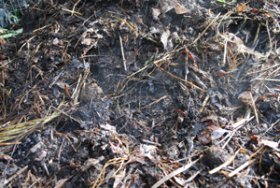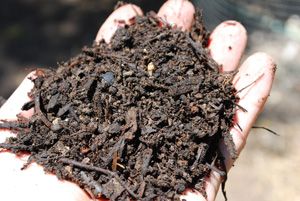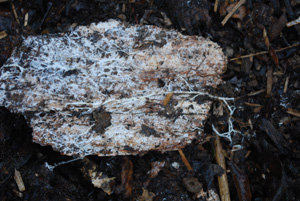Composting Basics
Composting basics covers choosing a site for your composting area, selecting compost materials, the size of the pile, aeration, moisture, and curing.

|
|
© Steve Masley…Click IMAGE to Enlarge |
The composting process is the same, whether you use a compost bin, compost tumbler, or simply build a compost pile.
All of these composting methods rely on aerobic decomposition.
The air-breathing bacteria and other soil organisms that break down the compost materials in the pile need oxygen to survive, and just enough moisture to thrive.
Site Selection
|
Materials
|
Size
|
Aeration
Moisture
|
Curing
How Does Composting Work?

|
|
© Steve Masley…Click IMAGE to Enlarge |
Composting is the transformation of waste into gardener's black gold, finished compost. The composting process can be slow or fast, depending on what compost materials you use and the size of the pieces that go into the pile, but the end result turns a waste problem into a garden solution.
Composting works by creating ideal conditions for microbes to multiply. The gardener controls what goes into the pile, whether it's whole, or in small pieces, and how moist it is, then steps back and lets bacteria and fungi do their work.
The gardener also controls how much air the pile gets. As microbial populations in the compost pile bloom, the bacteria eventually us up all the oxygen in the middle of the pile, and the gardener has to open up the core of the pile to let air in, or she loses the aerobic bacteria that are best at breaking materials down.
Building a compost pile and hot composting go detail on how to compost. But before you get started on composting, you need to think about a few composting basics.
Site Selection for Your Compost Pile
|
Compost Pages |
|---|
|
|
|
|
|
|
|
|
When starting a compost pile, the first step is to pick a site. It should be off to one side of the garden, in partial shade—full shade in hot climates. A northern or eastern exposure is usually best.
If you have close neighbors, consider the prevailing wind direction and how they use their yard. Try to avoid siting the compost pile upwind of or close to neighbors’ decks or picnic tables.
If you’re in a suburb or city, you may want to check the municipal code for regulations on composting, and set your composting site up accordingly.
You’ll need an area that’s a little more than double the size of the pile’s footprint, so you have room to turn it. A pile 3’ (1m) high will sprawl to a 6’ (2m) base.
When you’re cool composting, you may not have to turn the pile at all, but it will break down faster and more evenly if you turn it once or twice a month.
If you don’t have much space or you have neighbors close by, you may want to contain the pile in a compost bin or wire cylinder.
Don’t want to deal with turning a compost pile? Compost tumblers are rotating drums that make turning the pile easy.
After choosing a site to build a compost pile, the next step is collecting materials.
Materials
|
Site Selection
|
Materials
|
Size
Aeration
|
Moisture
|
Curing
Compost Materials
The basic process of making a compost pile involves layering “green” and “brown” materials in the right proportions, and keeping the layers moist—but not too moist!—as you build the pile.
In general, “green” materials are young and succulent, and have a higher nitrogen content than “brown” materials. Brown materials come from older plants with stiff stalks, and have a higher carbon content.
Compost Ingredients goes into greater depth on what to compost (and what not to compost), as well as how to blend compost ingredients to achieve the right balance between carbon and nitrogen in your compost pile.
Materials
|
Site Selection
|
Materials
|
Size
Aeration
|
Moisture
|
Curing
Composting Basics: Size of the Compost Pile
Size matters with compost piles. The size of the compost pile is one of the factors that determines how quickly the pile breaks down, and how soon your compost will be ready to use in the garden.
Larger compost piles hold in compost heat, which accelerates the rate of breakdown in the pile. Compost piles smaller than 3’ x 3’ x 3’ (1m x 1m x 1m) rarely develop enough heat to break down thoroughly.
The size of the pile depends on how much kitchen, garden, and yard waste your family generates, but you should aim for a pile that’s 3-4’ (90-120cm) high and 3-4’ (90-120cm) in diameter.
If you’re composting in winter, you’ll need at least a 4’ x 4’ x 4’ (120cm x 120cm x 120cm) pile to maintain compost heat through the winter. Composting basics 101: Bigger is better in winter.
Materials
|
Site Selection
|
Materials
|
Size
Aeration
|
Moisture
|
Curing
Composting Basics: Aerating Compost Piles
Aeration is probably the most critical of the composting basics.
Once the pile is built, you need to make sure the center of the pile stays aerated. Hot composting requires frequent—almost daily—turning for the first two weeks, but even a static compost pile will break down more thoroughly and evenly if it’s turned once or twice a month.
Aerating the compost pile is a necessary evil when you’re using aerobic (air-breathing) organisms to break down your kitchen, yard, and garden wastes.
In compost piles, the middle of the pile heats up, and materials in the middle break down more quickly and evenly than they do in the outer layers of the pile.
In the process, the organisms in the middle of the pile use up the available oxygen, and anaerobic bacteria begin taking over—that’s when you get problems with odors and nutrient losses from your compost pile.
Turning the compost pile opens up and aerates the middle of the pile, which keeps the aerobic bacteria going.
Mixing the inner and outer layers of the pile as you turn it exposes the coarser, less-broken-down materials from the outside of the pile to moist compost heat in the center. This produces a more complete breakdown of the materials and results in a finer-textured finished compost.
With compost piles, there’s always a certain amount of grunting, sweating, and yes, swearing (sometimes), associated with turning the compost pile.
A Compost Aerator
can help with a static compost pile, but for hot-composting, there’s no substitute for a thorough turning that mixes the inside with the outside of the pile.
Materials
|
Site Selection
|
Materials
|
Size
Aeration
|
Moisture
|
Curing
Composting Basics: Adjusting Moisture in Compost Piles
Compost moisture, like aeration, is one of the critical composting basics that you have to get right.
Aim for a 50% moisture level when you build the pile. This is about the moisture level of a wrung-out sponge. If you squeeze a handful of compost hard, only a drop or two of water should come out.
If the pile is too dry, bacteria can’t multiply to break down the compost ingredients. If the pile is too wet, aerobic bacteria can’t survive, and anaerobic bacteria take over the pile, resulting in foul odors and nutrient losses.
It’s best to moisten the pile as you’re building it, using a water wand with a soft spray setting
. The stream from the end of a bare hose won’t wet the pile evenly—it produces saturated areas and dry areas—and pistol-grip sprayers tend to blast the pile.
Green layers usually just need a splash. Brown layers, especially thick ones, need to be watered longer.
Adjust the moisture of the compost pile when you turn it, wetting down dry areas, and mixing dry compost ingredients into saturated areas.
Keep the pile covered with plastic or a tarp to help control moisture levels. Plastic holds moisture in when it’s dry, and sheds excess moisture when it rains.
Materials
|
Site Selection
|
Materials
|
Size
Aeration
|
Moisture
|
Curing
Composting Basics: “Curing” Compost
When the middle of the pile starts cooling down—or when a static compost pile has reached maximum size for its site—it’s time to turn it out for the last time, and allow it to cure.
Compost is ready to use in the garden once the compost heat has subsided, and the pile is the same temperature as the surrounding environment.

|
|
© Steve Masley…Click IMAGE to Enlarge |
Immediately after the thermal phase, compost is dominated by bacteria, as opposed to fungi, which is perfect if you’re growing fall vegetables or cool-season crops, which evolved in bacterially-dominated soils.
Fruiting plants—like fruit trees, berries, tomatoes, peppers, eggplants, melons, and squash—evolved in soils with more fungi, so compost with a balance of bacteria and fungi is better for them.
By allowing the compost to cure for a few months after the hot phase, you allow time for beneficial fungi to infiltrate the compost.
Wet the ground down before turning the pile this last time, and make sure the pile is in contact with the ground.
I pull the composting cylinder away at this point, and let the pile sprawl.
In the curing phase, compost piles have an advantage over compost bins: a larger base in contact with the ground. This allows the forest floor ecosystem—insects, microarthropod “shredders”, red compost worms, and beneficial fungi—to enter the pile and go to work during the curing stage.
Water the top of the compost pile and cover it with a piece of plastic or a tarp, to keep it from drying out or getting too wet.
Curing compost for 1-4 months results in an even finer breakdown of the materials, and produces compost that’s rich in beneficial fungi.
Materials
|
Site Selection
|
Materials
|
Size
Aeration
|
Moisture
|
Curing
Top of Composting Basics
|
How to Compost
Build a Compost Pile
|
Compost Ingredients
|
Hot Composting
Setting Up a Worm Composting System
Copyright © 2009-2025, by Steve Masley, Grow-it-Organically.com
All rights reserved
HOME | About Us | Contact Us | Privacy
New! Comments
Have a question or comment about what you just read? Leave me a comment in the box below.